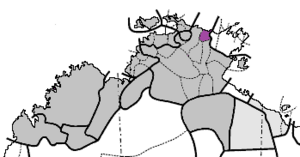Maningrida languages facts for kids
Quick facts for kids Maningrida |
|
|---|---|
| Burarran | |
| Geographic distribution: |
Northern Territory |
| Linguistic classification: | Macro-Gunwinyguan?
|
| Subdivisions: | |
 Maningrida languages (purple), among other non-Pama-Nyungan languages (grey)
|
|
The Maningrida languages, also called Burarran, are a small group of Australian Aboriginal languages. They are spoken by Indigenous people in the northern part of Northern Territory, Australia. This language family includes four main languages. Even though they are in the same family, they are not super closely related. Think of them like cousins, not siblings!
The four languages in the Maningrida family are:
What are Maningrida Languages?
A language family is a group of languages that have grown from a single older language. This older language is called a "proto-language." For example, English and German are part of the Germanic language family.
The Maningrida languages are part of a bigger group called Arnhem languages. These languages are known for their complex grammar. They are different from many other Australian languages.
How Linguists Study Language Families
Scientists who study languages are called linguists. They look for clues to see if languages are related. One linguist, named Green, studied the Maningrida languages. He looked at how verbs change to show when something happened (like past, present, or future). This is called "tense–aspect–mood" or TAM.
By studying these changes, Green found common patterns in the Maningrida languages. These patterns showed that they shared a history. This helped him prove they belonged to the same language family. It also showed how they were different from other languages in the Arnhem region.
Linguists also compare basic words across languages. Words like "man," "woman," "head," or "water" can show connections. If many basic words are similar, it's a good sign the languages are related. This helps linguists build a "family tree" for languages.
See also


